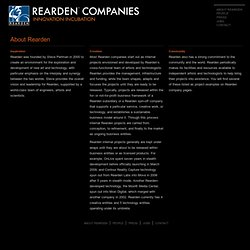

About Rearden. Inspiration Rearden was founded by Steve Perlman in 2000 to create an environment for the exploration and development of new art and technology, with particular emphasis on the interplay and synergy between the two worlds.

Steve provides the overall vision and leadership for Rearden, supported by a world-class team of engineers, artists and scientists. Creation Most Rearden companies start out as internal projects envisioned and developed by Rearden’s cross-functional team of artists and technologists. Rearden provides the management, infrastructure and funding, while the team shapes, adapts and focuses the projects until they are ready to be released.
Typically, projects are released within the for- or not-for-profit business framework of a Rearden subsidiary or a Rearden spin-off company that supports a particular service, creative work, or technology, and establishes a sustainable business model around it. Www.rearden.com/DIDO/DIDO_White_Paper_110727.pdf. Impossible Software. Dean Bubley's Disruptive Wireless. Tech Trends. Great Scott! Scientists Claim Time Travel Is Possible. Forget the Verizon iPhone, the rumored iPad 2, or even my beloved annual Winter NAMM Show 2011--this is clearly the discovery of the year.

You might want to be sitting down for this one. Jay Olson and Timothy Ralph at the Department of Physics over at the University of Queensland in Australia recently published a paper entitled: "Extraction of timelike entanglement from the quantum vacuum". In the roughly seven- to eight-page document filled with equations I will probably never understand, the two discuss and conclude on what appears to be the discovery of "teleportation in time" (aka. Time Travel). So apparently the hot word of the day is: Entanglement. The type of quantum entanglement that Jay Olson and Timothy Ralph are talking about in their paper discusses nonlocality not in terms of physical space (distance), but rather in terms of time, thus "timelike entanglement. " Take the following graph: Now, look at how the two sides mirror each other from the "X" point.
Like this? MIT Creates Amazing UI From Levitating Orbs. Anyone else see The Avengers?

Just like in Iron Man 1 and 2, Tony Stark has the coolest interactive 3-D displays. He can pull a digital wire frame out of a set of blueprints or wrap an exoskeleton around his arm. Those moments aren’t just sci-fi fun; they’re full of visionary ideas to explore and manipulate objects in 3-D space. Except for one thing: How would Stark feel all of these objects to move them around?
In reality, he’d be touching nothing but air. Jinha Lee, from the Tangible Media Group of the MIT Media Lab, in collaboration with Rehmi Post and Hiroshi Ishii, has been playing with the idea of manipulating real floating objects in 3-D space to create a truly tactile user interface. It’s essentially a small field in which gravity doesn’t overcome an object. “There is something fundamental behind motivations to liberate physical matter from gravity and enable control. Interviewing Lee, I realized he’s one-part scientist, one-part philosopher. [Hat tip: designboom]